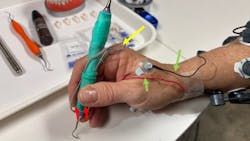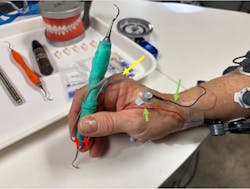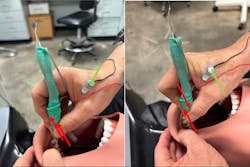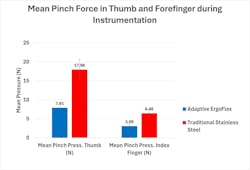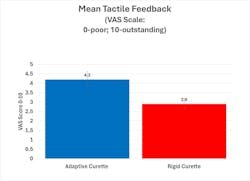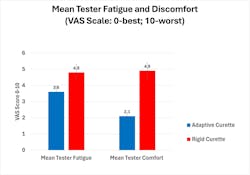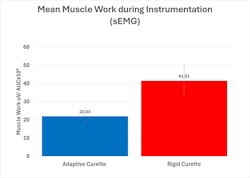Dental ergonomics and instrument design: How adaptive curettes reduce muscle strain and improve clinician comfort
What you'll learn in this article
-
How adaptive curette handle design reduces pinch force, muscle activity, and fatigue compared to traditional rigid handles
-
Why ergonomic factors such as grip distribution, tactile feedback, and muscle effort play a critical role in clinician comfort and long-term musculoskeletal health
-
Practical insights from a controlled study showing that adaptive instruments maintain clinical efficacy while improving ergonomics for dental professionals
Listen to the article on our podcast!
Ergonomic outcomes: Cause and effect
A recent article in RDH magazine titled, “Is dental hygiene a 10-year career?” highlighted the serious health risks associated with our profession.1 Dental hygienists experience the highest prevalence of instrumentation-related musculoskeletal disorders (MSDs) of any profession, with 64%–96% experiencing MSD-related pain and dysfunction each year.2 The related annual income loss is estimated at $131 million.³ Thus, it is not surprising that interest in dental ergonomics is growing rapidly, including a sharp rise in publications, educational programs, and new research focused on ergonomics.
The changing landscape of instrument design
Over the last decade, the design of hand instruments has undergone considerable transformations that include modifications in instrument shape, size, weight, and materials. Even the centuries-old concept of rigid instrument handles is being challenged. Recent studies suggest that adaptive handle designs—those that can be shaped to custom fit each clinician’s grip—can offer notable ergonomic advantages.4,5
While earlier studies have often focused on isolated outcomes such as comfort or fatigue, it is now understood that musculoskeletal health is shaped by a complex interplay of many factors. Key clinical outcomes include:
- The amount of muscle work required during scaling
- The level of fatigue and discomfort reported during and after use
- Pinch force during instrumentation and its distribution between the thumb and forefinger
- Tactile feedback and timely identification of work endpoints
This wide range of outcomes highlights the need for more comprehensive ergonomic evaluations that consider all the important variables simultaneously.
Study objective
The goal of this study was to compare the ergonomic performance of two dental curettes—one with a rigid handle and the other with an adaptive handle. Our long-term goal is to identify the most relevant parameters for ergonomic assessment to inform future ergonomic research models and ultimately improve instrument design.
Study protocol
This study was granted exempt status by the University of California Irvine IRB, as only de-identified, coded data were recorded during testing in typodont models.
Instruments tested
Two curettes with nearly identical weight and dimensions were used:
- A rigid stainless steel-handled scaler
- An adaptive silicone-over-stainless steel-handled scaler
Instrumentation and measurements
Real-time, continuous surface electromyography (sEMG) measured muscle activity in four key muscles involved in dental instrumentation:
- Abductor pollicis brevis
- First dorsal interosseous
- Flexor pollicis longus
- Extensor digitorum communis
To measure grip force, two thin-film minipressure sensors linked to a microcontroller were mounted on the instrument where it is gripped by the thumb and forefinger using a thin sheath (Handix; figure 1).
Testing procedure
Each tester was asked to remove all supragingival artificial calculus from a typodont model (Acadental; figure 2). They used the first instrument for five-minute intervals followed by one-minute rests, over a total of 40 minutes. After a 30-minute break, the same process was repeated with the second instrument. Participants then completed VAS questionnaires rating the following variables on a scale of 0-10:
- Comfort
- Fatigue
- Tactile feedback
Finally, the typodonts were photographed and calculus removal assessed using Image J software.
SPSS 19 statistics software was used to perform data analysis by means of a general linear model with pairwise tests for differences between instruments, followed by Tukey’s post hoc test. Significance was set at p < 0.05.
Results and discussion
Testers removed a similar amount of calculus with each curette: 95% (+7%) using the rigid and 95.8% (+6%) using the adaptive instrument, indicating that the rigid versus adaptive curette design did not affect clinical efficacy. However, significant differences were observed in pinch force, muscle effort, and user-reported outcomes (figure 3). Testers applied nearly twice as much pinch force when using the rigid curette compared to the adaptive instrument, and muscle activity was similarly increased with the rigid curette.
In both cases, the differences were statistically significant. As pinch force is produced through muscle effort, these variables are inherently linked and should be jointly evaluated in ergonomic assessments. Pinch force during instrumentation—regardless of the instrument used—was consistently two to three times greater in the thumb than in the forefinger, a pattern consistent with previous findings.6,7 This suggests an opportunity to optimize grip force distribution between the fingers to enhance ergonomic performance. Additionally, the significantly lower muscle activity observed with the adaptive curette was associated with significantly reduced fatigue and increased comfort, reinforcing the ergonomic advantages of the adaptive design. These results are consistent with prior research in this area.6,7 Tactile feedback was rated 30% higher for the adaptive curette, reflecting improvements in material properties and instrument design, as well as the integration of advanced tactile sensor technology. Improved tactile sensitivity may enable clinicians to “feel” the tooth surface more accurately, potentially reducing redundant strokes and thereby decreasing overall physical exertion during instrumentation.
Conclusions and future directions
The ergonomic performance of dental instruments involves multiple interrelated variables. Key areas for future exploration include:
- Improving the balance of pinch force between thumb and forefinger
- Investigating how adaptive handles distribute force to larger hand and forearm muscles
- Evaluating the influence of hand size on outcomes
- Assessing the value of enhanced tactile feedback in reducing unnecessary instrumentation
- Studying the relationship between muscle activity in individual muscles and overall discomfort, fatigue, and MSD risk
Editor's note: This article appeared in the October 2025 print edition of RDH magazine. Dental hygienists in North America are eligible for a complimentary print subscription. Sign up here.
References
- Hill A. Is dental hygiene a 10-year career? RDH. July 1, 2024. https://www.rdhmag.com/career-profession/article/55055772/is-dental-hygiene-a-10-year-career
- Marshall ED, Duncombe LM, Robinson RQ, Kilbreath SL. Musculoskeletal symptoms in New South Wales dentists. Aust Dent J. 1997;42(4):240-246. doi:10.1111/j.1834-7819.1997.tb00128.x
- Voruganti K. Practice dentistry pain-free: evidence-based strategies to prevent pain and extend your career. Br Dent J. 2009;206(3):181.
- Zozaya O, Bratt, L, Shayo K, Davis A. Effect of handle design and material on the ergonomic performance of a dental sickle scale. J Oral Med Dent Res. 2025;6(1):1-11. doi:10.52793/JOMDR.2025.6(1)-87
- Wink C, Yang SM, Habib AA, Lin K, Takesh T, Wilder-Smith P. Effect of a novel adaptive handle design on the ergonomic performance of periodontal curettes in dental hygienists with and without musculoskeletal disorders: a pilot clinical study. Dent J (Basel). 2024;12(8):253. doi:10.3390/dj12080253
- Lin K, Wink C, Dolan B, et al. A novel ergonomic curette design reduces dental prophylaxis-induced muscle work and fatigue. Dent J (Basel). 2023;11(12):272. doi:10.3390/dj11120272
- Wink C, Lin K, Dolan BE, Osann K, Habib AA, Wilder-Smith P. Evaluating the ergonomic performance of a novel periodontal curette with adaptive handle design. Hygiene. 2024;4(2):164-177. doi:10.3390/hygiene4020013
About the Author

Petra Wilder-Smith, DDS, DMD, PhD
Petra Wilder-Smith, DDS, DMD, PhD, is a professor of surgery, director of dentistry, and fellow of the Comprehensive Cancer Center at the University of California, Irvine. Her research interests include advancing the health and well-being of dental clinicians through improved ergonomic design and evaluation and improving oral cancer outcomes through the development of innovative screening and diagnostic technologies. Dr. Wilder-Smith is principal investigator on multiple NIH- and NCI-funded studies, and she serves on many advisory boards and journal editorial boards.
